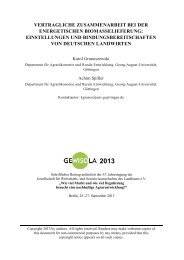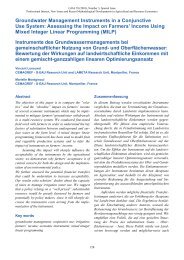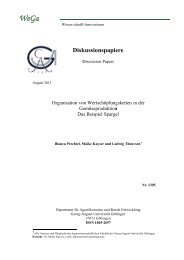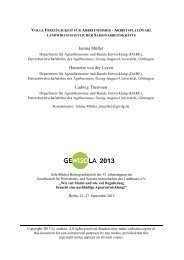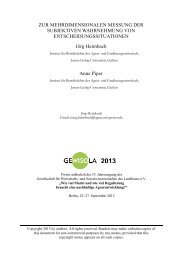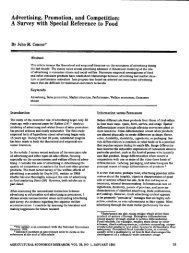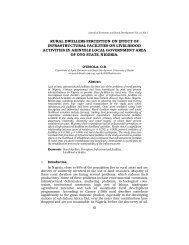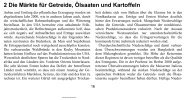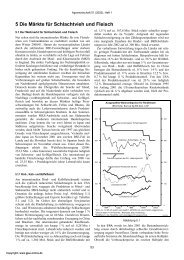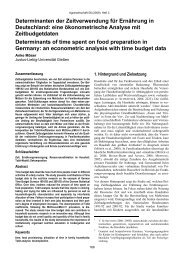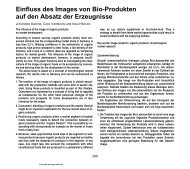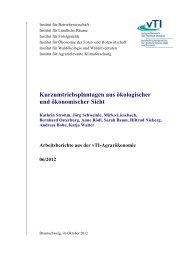View/Open - AgEcon Search - University of Minnesota
View/Open - AgEcon Search - University of Minnesota
View/Open - AgEcon Search - University of Minnesota
You also want an ePaper? Increase the reach of your titles
YUMPU automatically turns print PDFs into web optimized ePapers that Google loves.
Prepared by the Dlvisio1111 <strong>of</strong> Aqricultural Economics and Aqrlcultural Exte11111oa<br />
Paul E. Miller, Director Aqricultural Extelllllon<br />
NO. 194 UNIVERSITY FARM, ST. PAUL FEBRUARY 1939<br />
FOREIGN TRADE AGREEMENTS<br />
Farmers have a special interest<br />
in the trade agreements program because<br />
<strong>of</strong> the dependence <strong>of</strong> agriculture<br />
upon foreign markets. These<br />
outlets have been curtailed by the depression<br />
and the extensive trade<br />
restrictions arising out <strong>of</strong> it. While<br />
the foreign market has been reduced,<br />
agriculture in the United States has<br />
not been adjusted accordingly. It<br />
is still geared to an export market <strong>of</strong> considerable importance.<br />
If that market is not restored, it will be necessary<br />
to curtail production <strong>of</strong> American agriculture pennanently.<br />
This is due to the fact that replacements for the<br />
foreign markets which fanners have had in the past are not<br />
in sight. The rate <strong>of</strong> population growth is slowing down<br />
and a stationary, if not actually declining, population is in<br />
prospect. The intake <strong>of</strong> food is definitely limited, and any<br />
considerable increase in the per capita consumption <strong>of</strong> farm<br />
products is not likely. Industrial uses may expand in time,<br />
but the development in this direction does not promise a<br />
replacement for the foreign market in the near future. Opportunities<br />
for growing agricultural products now imported<br />
are too limited to provide the way out.<br />
Considerable interest is being shown in a "two-piece"'<br />
plan involving some form <strong>of</strong> fixing or control <strong>of</strong> prices sold<br />
in the domestic market with sale <strong>of</strong> the surplus on the<br />
world market for whatever it will bring. Is this a satisfactory<br />
method <strong>of</strong> trade recovery? This plan assumes that<br />
other countries stand ready to accept such products generally.<br />
Attempts to sell products abroad at prices lower<br />
than those in the country from which the shipments come<br />
are a form <strong>of</strong> export dumping. Many countries, including<br />
the United States, have restrictions against clumping and<br />
these are likely to be employed against such a plan. Payment<br />
for these exports would still have to be mainly in the<br />
form <strong>of</strong> imports <strong>of</strong> goods and services and consequently<br />
would not be forthcoming unless we are willing to trade,<br />
that is to accept imports. Such a plan, however, is likely<br />
to lead to demands for higher protection rather than<br />
g:eater imports. It is also questionable whether it is ad<br />
VIsable to follow a policy <strong>of</strong> making products available to<br />
foreign countries at lower prices than those paid by our<br />
own people.<br />
By 0. B. }ESNESS<br />
Are You Listening?<br />
UNIVERSITY FARM HOUR<br />
12:30 to 1:00 p.m.<br />
Monday- Wednesday- Friday<br />
Station WIJ!-,760 on the dial<br />
The alternative before this country,<br />
therefore, is in large measure<br />
one <strong>of</strong> either expanding foreign<br />
trade or else curtailing agriculture to<br />
fit the smaller market. Those who<br />
protest that concessions required to<br />
regain lost markets involve costs<br />
need to bear in mind that the adjustments<br />
which will be needed if export<br />
markets are lost are far from<br />
being costless.<br />
Dairymen, livestock producers, and others operating<br />
behind a tariff wall may be told that while trade expansion<br />
may be important to lines dependent upon exports, their<br />
interests lie in maintaining and increasing trade restrictions.<br />
This is entirely too narrow a view <strong>of</strong> the problem. If<br />
farmers who produce for export lose part <strong>of</strong> that market,<br />
they will naturally endeavor to make adjustments in their<br />
farming. These adjustments are likely to include some<br />
shift to production for the domestic market. If corn and<br />
hog producers have to curtail production because foreign<br />
markets for pork and lard are not recovered, some <strong>of</strong> them<br />
vvill expand their dairy and beef enterprises. If cotton<br />
exports are permanently reduced, some cotton farmers mav<br />
go into livestock. The same is true <strong>of</strong> wheat. This is why<br />
it is important to see the whole trade picture rather than<br />
to draw conclusions on the basis <strong>of</strong> a few products or rates.<br />
The agreements with Canada and the United Kingdom<br />
have attracted the most attention. This is only natural<br />
because England is our most important foreign agricultural<br />
customer and Canada is our most important outlet for industrial<br />
goods. The difference <strong>of</strong> our market interest in<br />
the two countries suggests why the concessions obtained<br />
and granted in these agreements differ so greatly. Canada<br />
is more dependent upon agriculture than is the United<br />
States and some <strong>of</strong> the important Canadian export products<br />
are those produced in this country. This explains why<br />
some <strong>of</strong> the concessions granted Canada are on agricultural<br />
items and also why Canadian concessions, although including<br />
many farm products, give an important place to industrial<br />
imports. The latter are not without interest to<br />
farmers because <strong>of</strong> the close relationship between employment,<br />
consumers' buying power, and the markets for farm<br />
products.
Page Two FARM BUSINESS NOTES February 1939<br />
Space permits mention <strong>of</strong> only a few <strong>of</strong> the items included<br />
in these agreements. The concessions granted on<br />
livestock and dairy products in the Canadian agreement<br />
have received the most attention. The former agreement<br />
with Canada reduced the duty on a quota <strong>of</strong> about 156,000<br />
head <strong>of</strong> cattle, 700 pounds and over, from 3 cents a pound<br />
to 2 cents. The new agreement increased the annual quota<br />
to 225,000 head and reduced the rate on it to 10 cents,<br />
but limited the quota for any one quarter at 60,000 head.<br />
Imports in excess <strong>of</strong> quotas pay the full rate. A rate <strong>of</strong><br />
10 cents is fixed on a quota <strong>of</strong> 100,000 calves <strong>of</strong> 200<br />
pounds or less. The duty on dairy cows was reduced to<br />
10 cents and the quota provision eliminated. Even though<br />
imports have been somewhat larger than the quotas, they<br />
amounted to only 2.8 per cent <strong>of</strong> the inspected slaughter <strong>of</strong><br />
cattle and calves in 1937 and only 2 per cent for the first<br />
ten months <strong>of</strong> 1938. While concessions were made by both<br />
Canada and the United States on hogs and pork, these are<br />
not very significant because both countries normally are on<br />
an export basis.<br />
The 14-cent duty on butter has not been changed by<br />
any <strong>of</strong> the agreements. The rate on cheddar cheese, which<br />
was reduced from 7 to 5 cents in the first agreement with<br />
Canada, has been reduced to 4 cents but not less than 25<br />
per cent ad valorem. Imports from Canada in 1937 equaled<br />
about one per cent <strong>of</strong> the United States production, and<br />
those in 1938 were only about one-third <strong>of</strong> those in 1937.<br />
The duty on a quota <strong>of</strong> 1,500,000 gallons <strong>of</strong> cream was reduced<br />
from 56.6 cents to 35 cents by the first agreement,<br />
and to 28.3 cents by the new agreement. This quota represents<br />
only a very small fraction <strong>of</strong> the total supply, and<br />
during the three years it has been in effect only about 4<br />
per cent <strong>of</strong> it has come in. Thus, imports in 1937 were<br />
only 137,000 gallons, and in 1938 only 5,100 gallons. The<br />
rate on a quota <strong>of</strong> 3,000,000 gallons <strong>of</strong> milk was lowered<br />
from 6.5 cents to 3.25 cents. These limited quotas and<br />
imports do not support claims that dairy markets are<br />
seriously threatened by the agreement.<br />
A number <strong>of</strong> the concessions granted by Canada relate<br />
to agricultural products. However, the greater importance<br />
<strong>of</strong> industrial products in our exports to Canada makes<br />
concessions on the latter more significant. To conclude that<br />
the agreement makes concessions on agricultural products<br />
for the benefit <strong>of</strong> manufacturing lines is to overlook the<br />
relationship between industrial activity and the outlets for<br />
farm products. Recovery <strong>of</strong> employment and consumer<br />
purchasing power is particularly important for livestock<br />
and dairy products.<br />
The agreement with the United Kingdom is important<br />
to American farmers because England is the leading buyer<br />
<strong>of</strong> American farm exports. The removal <strong>of</strong> the 10 per<br />
cent duty on American lard and the increase in the quota<br />
<strong>of</strong> American hams to 56 million pounds for 1939, with<br />
possibilities <strong>of</strong> further increases later, are important. The<br />
increase now under way in hog production will make expansion<br />
<strong>of</strong> exports essential to the maintenance <strong>of</strong> satisfactory<br />
hog prices. The removal <strong>of</strong> the duty on lard should<br />
improve upon the competitive position <strong>of</strong> lard among the<br />
fats and oils in the British market. The British duty on<br />
wheat <strong>of</strong> about 6 cents a bushel is removed. Wheat exports<br />
were negligible during the drouth years, but more<br />
normal producing conditions have put this country back on<br />
an export basis. Other concessions include such agricultural<br />
products as rice, apples, pears, various canned and<br />
dried fruits, and other items.<br />
The concessions granted by the United States relate<br />
mainly to industrial products and raw materials rather than<br />
to important agricultural products.<br />
One viewpoint maintains that these two agreements are<br />
against the interests <strong>of</strong> dairymen and cattle producers because<br />
some concessions have been made on their products<br />
and that the only concessions on livestock products obtained<br />
in return are on pork and lard. As we do not<br />
normally export butter, cheese, or beef, it is not clear what<br />
other concessions these producers could receive. The dairy<br />
industry is now at a point where the principal concern is<br />
one <strong>of</strong> finding outlets rather than one over the threat <strong>of</strong><br />
dairy imports. In spite <strong>of</strong> the 14-cent duty on butter, the<br />
New York price during the last year has not been much<br />
above London. Actually, it was lower for some time last<br />
summer. This resulted from the fact that domestic demand<br />
was not adequate to absorb the supplies at higher prices.<br />
A government purchase program was necessary to keep<br />
prices from falling still lower. The interests <strong>of</strong> dairymen<br />
lie in an improvement in employment and business conditions<br />
and an increase in export outlets for other agricultural<br />
products to keep their producers from expanding<br />
dairying. Increasing cattle production in prospect for the<br />
coming years is likely to make the same situation apply<br />
to beef.<br />
Present indications are that attacks upon the trade<br />
agreements program from interests which believe they are<br />
harmed will continue. Farmers who are asked to join in<br />
these attacks will do well to consider the entire problem involved<br />
instead <strong>of</strong> arriving at conclusions based on a consideration<br />
<strong>of</strong> only part <strong>of</strong> it. Failure to do so may lead<br />
them to take a stand contrary to their own best interest.<br />
Prospects for the Poultry Enterprise<br />
By WILLIAM H. DANKERS<br />
The feed-egg ratio (the number <strong>of</strong> dozen eggs required<br />
to buy one hundred pounds <strong>of</strong> poultry ration), based upon<br />
prices at Chicago, was high during January. This is the<br />
reverse <strong>of</strong> a favorable low feed-egg ratio from May through<br />
the first half <strong>of</strong> December 1938. The upward change in<br />
the ratio was the result <strong>of</strong> the greater-than-seasonal decline<br />
in egg prices during January, since feed prices made on~y<br />
the usual seasonal advance. Changes in the feed-egg ratiO<br />
during the next few months will depend largely on ~he<br />
trend <strong>of</strong> egg prices. With the approach <strong>of</strong> the hatchm.g<br />
season, an upward swing in egg prices is expected, and tlus<br />
should result in a more favorable feed-egg ratio.<br />
The number <strong>of</strong> hens and pullets <strong>of</strong> laying age in farm<br />
flocks on January 1, 1939 was about seven per cent above<br />
the record low on the same date in 1938 but five per cent<br />
below the ten-year average, 1926-1935. The increase in<br />
size <strong>of</strong> laying flocks from the low point in August 1938 to<br />
January 1, 1939 was the largest on record.<br />
Production per hen on January 1, 1939 was eight.per<br />
cent above January 1, 1938, which had been the prevwus
February 1933 FARM BUSINESS NOTES Page Three<br />
high for the month <strong>of</strong> January, and almost fifty per cent<br />
above the ten-year ( 1925-1934) January 1 average.<br />
Production per farm flock on January 1, 1939 was 16<br />
per cent above January 1 last year and 41 per cent above<br />
the 1925-1934 January average.<br />
The very large egg production per farm flock the last<br />
several months is largely responsible for the greater-thanseasonal<br />
price decline which has occurred. Because <strong>of</strong> the<br />
early sharp drop in December and January, the seasonal<br />
decline which usually occurs in the remaining winter<br />
months is expected to be less than usual.<br />
Commercial hatchings in November and December 1938<br />
were well above the same months in 1937, pointing to<br />
larger market supplies <strong>of</strong> winter broilers during January,<br />
February, and early March. Storage stocks <strong>of</strong> poultry also<br />
will be larger than in those months last year. This combined<br />
with an expected record hatch in the spring <strong>of</strong> 1939<br />
and severe competition from increased supplies <strong>of</strong> other<br />
meats indicates that the anticipated higher level <strong>of</strong> consumers'<br />
incomes and demand will very likely not be sufficient<br />
to <strong>of</strong>fset the depressing effects <strong>of</strong> these larger supplies.<br />
Prices for poultry meats are, therefore, expected to<br />
be relatively low in 1939.<br />
The size <strong>of</strong> the 1939 spring hatch is to some extent<br />
dependent upon the trend in egg prices from this point on.<br />
Considering the year 1938 as a whole, the poultry enterprise<br />
provided a relatively desirable market for the lowpriced<br />
feed. This along with a lack <strong>of</strong> alternatives in<br />
marketing the abundant supply <strong>of</strong> low-priced feed that is<br />
now on hand is an encouragement for maintaining and increasing<br />
the size <strong>of</strong> hatch. For this reason, the largest<br />
hatch on record is expected this spring.<br />
Consideration might well be given by the poultry producer<br />
to the status <strong>of</strong> his enterprise. It is doubtful whether<br />
expenditures can be justified for an expansion <strong>of</strong> physical<br />
facilities so as to accommodate a larger hatch. Producers<br />
who have crowded their facilities might well reduce numbers<br />
to avoid crowding and to permit better management.<br />
In all probability, the sale <strong>of</strong> broilers on a relatively early<br />
market and early laying pullets in the fall <strong>of</strong> 1939 will add<br />
considerably to the income from the poultry enterprise for<br />
the year 1939.<br />
With expected lower prices, costs must be held down<br />
if a margin is to be obtained. The need for obtaining<br />
healthy and vigorous chicks, adopting a sanitation plan, and<br />
providing careful management can not be stressed too much.<br />
Rail and Truck Receipts <strong>of</strong> Livestock at South St. Paul by Distance Zones<br />
By A. A. DowELL and LEo FENSKE<br />
The figures in the table indicate that a higher proportion<br />
<strong>of</strong> combined <strong>Minnesota</strong> rail and truck shipments <strong>of</strong><br />
hogs and calves to South St. Paul during 1937 came from<br />
nearby zones than <strong>of</strong> cattle, and a higher proportion <strong>of</strong> cattle<br />
than <strong>of</strong> sheep and lambs. This is in part a reflection<br />
<strong>of</strong> the various type-<strong>of</strong>-farming areas in the state. Over<br />
65 per cent <strong>of</strong> the hogs and 67 per cent <strong>of</strong> the calves came<br />
from within a radius <strong>of</strong> 100 miles, whereas 53 per cent <strong>of</strong><br />
the cattle and 37 per cent <strong>of</strong> the sheep and lambs came<br />
from within this area. About 2 per cent <strong>of</strong> the hogs, 9 per<br />
cent <strong>of</strong> the calves, 11 per cent <strong>of</strong> the cattle, and 22 per cent <strong>of</strong><br />
the sheep and lambs came from beyond the 175-mile radius.<br />
Truck shipments <strong>of</strong> each species were made from all<br />
parts <strong>of</strong> <strong>Minnesota</strong>. Such shipments accounted for 86 per<br />
cent <strong>of</strong> the combined rail and truck shipments <strong>of</strong> cattle from<br />
<strong>Minnesota</strong> farms to this market in 1937. Similarly, 88 per<br />
cent <strong>of</strong> the calves, 86 per cent <strong>of</strong> the hogs, and 77 per cent<br />
<strong>of</strong> the sheep and lambs <strong>of</strong> <strong>Minnesota</strong> origin came by truck.<br />
These figures are considerably higher than comparable figures<br />
based on total shipments to this market from all states.<br />
When comparing truck shipments by zones for each<br />
species, it will be noted that a higher proportion <strong>of</strong> calves<br />
came from the 26-50-mile zone than from any other 25-mile<br />
zone, and the highest proportion <strong>of</strong> hogs came from the<br />
51-75-mile zone. The heaviest truck shipments <strong>of</strong> <strong>Minnesota</strong><br />
sheep and lambs and cattle came from the 76-100-<br />
mile zone. <strong>Minnesota</strong> truck shipments within the 100-mile<br />
radius accounted for 74 per cent <strong>of</strong> the total truck shipments<br />
<strong>of</strong> calves, 71 per cent <strong>of</strong> the hogs, 58 per cent <strong>of</strong> the<br />
cattle, and 45 per cent <strong>of</strong> the sheep and lambs.<br />
On the other hand, a higher percentage <strong>of</strong> rail shipments<br />
came from greater distances than die! the truck shipments.<br />
A higher proportion <strong>of</strong> rail shipments <strong>of</strong> each<br />
species from <strong>Minnesota</strong> farms came from the 151-175-mile<br />
zone than from any zone closer to the market. Rail shipments<br />
beyond the 175-mile radius accounted for 52 per cent<br />
<strong>of</strong> the total rail shipments <strong>of</strong> sheep and lambs from <strong>Minnesota</strong><br />
farms to South St. Paul, compared vvith 33 per cent<br />
<strong>of</strong> the cattle, 28 per cent <strong>of</strong> the calves, and 6 per cent <strong>of</strong><br />
the hogs.<br />
Distribution <strong>of</strong> Rail and Truck Receipts <strong>of</strong> Cattle, Calves, Hogs, and Sheep from <strong>Minnesota</strong><br />
to South St. Paul, According to Distance Shipped, 1937*<br />
Proportion <strong>of</strong> to·~al<br />
receipts <strong>of</strong> each species<br />
Distance <strong>of</strong> Cattle Calves Hogs Sheep<br />
shipment ------------ --------<br />
Rail Truck Total Rail Truck Total Rail Truck Total Rail Truck Total<br />
miles % % % % % % % % % % % %<br />
0- 25 0.0 6.6 5.6 0.0 8.9 7.9 0.0 5.3 4.6 0.0 6.7 5.2<br />
26- 50 0.6 12.9 11.2 1.1 25.8 22.9 1.3 18.8 16.5 0.1 5.6 4.4<br />
51- 75 3.7 17.2 15.3 5.4 19.5 17.8 3.6 24.8 22.0 0.8 14.5 11.5<br />
76-100 ....................................... 18.0 21.5 21.0 14.0 19.3 18.7 18.5 22.3 21.8 5. 7 18.7 15.6<br />
101-125 12.0 15.8 15.3 17.2 8.5 9.5 12.0 13.4 13.2 3.0 17.3 14.2<br />
126-150 7.4 9.9 9.6 9.2 4.0 4.7 23.5 7.4 9.5 6.1 12.9 11.5<br />
151-175 25.0 8.7 11.0 25.3 7. 7 9.8 35.1 6.1 9.9 32.5 10.7 15.5<br />
176 and over . .. -·- ....... 33.3 7.4 11.0 27.9 6.2 8.8 6.0 2.0 2.4 51.9 13.5 21.8<br />
*Source: St. Paul Union Stock Yards Company bulletin sheets. Data based upon receipts for one full week in each month during 1937.
Page Four FARM BUSINESS NOTES February 1939<br />
<strong>Minnesota</strong> Farm Prices for January 1939<br />
Prepared by W. C. WAITE and W. B. GARVER<br />
The index number <strong>of</strong> <strong>Minnesota</strong> farm prices for the<br />
month <strong>of</strong> January 1939 was 69. When the average <strong>of</strong> farm<br />
prices <strong>of</strong> the three Januarys 1924-25-26 is represented by<br />
100, the indexes for January <strong>of</strong> each year from 1924 to<br />
date are as follows :<br />
January 1924 ........ .. 86 January 1930 ........... .100 January 1935 ............ 81<br />
January 1925 ........... .102 January 1931 .......... 73 January 1936 ....... ... 84<br />
January 1926 ............ 113 January 1932 ............ 48 January 1937 .. .... 100<br />
January 1927 ........... 112 January 1933 ..... 36 January 1938 ... 80*<br />
January 1928 ........... 100 January 1934 ..... 45 January 1939 ............ 69*<br />
January 1929 ............ 101<br />
* Preliminary<br />
The price index <strong>of</strong> 69 for the past month is the net<br />
result <strong>of</strong> increases and decreases in the prices <strong>of</strong> farm products<br />
in January 1939 over the average <strong>of</strong> January 1924-<br />
25-26, weighted according to their relative importance.<br />
Average Farm Prices Used in Computi!lg the MinJ?-esot~ Farm<br />
Price Index January 15, 1939, w1th Compansons ·<br />
.,; .,; .,; .,; .,; .,;<br />
• 0> ·co .., • 0> ..,<br />
0~<br />



